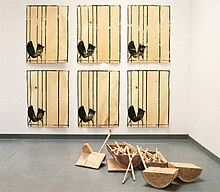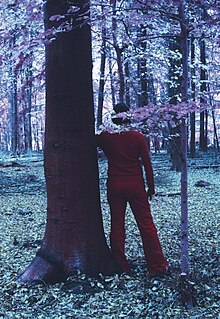Christoph M. Loos
Christoph M. Loos , FRSA (* 1959 in Bad Reichenhall ) is a German artist in the media of printmaking, sculpture, drawing and photography, art theorist and temporary university lecturer. With his woodcuts, which are consistently interpreted conceptually and in the border area between sculpture and graphics, he is currently one of the most important artists of contemporary printmaking in German-speaking countries .
biography
Christoph M. Loos grew up in Bad Reichenhall, Bad Sooden-Allendorf and Bad Wildungen. After graduating from high school in the early 1980s, he was initially involved in political, left-wing and sometimes anarchist ideas, particularly in the Socialist Self-Help Cologne (SSK). After an apprenticeship as a cabinet maker, Loos studied sculpture, philosophy and free graphics from 1988 to 1996 at the Düsseldorf Art Academy . From 2002 to 2013 he held various teaching positions and guest professorships, including in 2010 at the Accademia di Belle Arti di Brera in Milan. From 2004 to 2007 he was at the University of Design Offenbach am Main , the Dix-endowed professorship held. With the work The Palace at 3 am (Ordo Inversus). A Woodcut [Re-] Invention in Resonance with Merleau-Ponty's 'Chiasma' , in which he reflects on his own woodcut method in media theory and philosophy, he was awarded a Doctor of Philosophy (Ph.D.) in 2014 at the Manchester School of Art ( Manchester Metropolitan University ) .) PhD.
Loos works in Grafschaft (Rhineland-Palatinate) near Bonn and in Essen, he has two sons and a daughter. His eldest son completed his studies in Human, Social and Political Sciences (HSPS) at the University of Cambridge in 2016 with a top grade and special distinction.
family
Loos is the son of the psychosomatic specialist Manfred Loos (1920–1975) - most recently chief physician of the Werra sanatorium in Bad Sooden-Allendorf - and grandson of Wilhelm Loos (1890–1952). He is also related to the Viennese architect and architectural theorist Adolf Loos (1870–1933). As a student of Arnold Böcklin, his great-grandmother Johanna Ernestine Katz (1863–1952) was one of the few women studying art of her time.
plant
Woodcuts - objects, installations and site-specific installations
Christoph M. Loos' woodcuts and woodcut installations have been shown in overview exhibitions since the 1990s, most recently in 2015 at the Museum Morsbroich Leverkusen . Characteristic of his work is a very sensual and conceptual view of his medium, his border crossing between sculpture and graphics, which sometimes leads to very large-scale installations. Another characteristic is the consistent methodical approach of always letting the print and the printing block emerge from a tree trunk by peeling it off. In 2006, the Japanese critic Goji Hamada wrote:
“It is nothing less than a system when Loos divides a tree [...] into wood leaves [...] and a cylindrical trunk [...] and that this part of the trunk becomes a printing block that prints on the wood leaves. This is how a system develops in which printing blocks and leaves are born from a tree and printing ink is applied to this shape of the printing block to produce a woodcut. This creates an astonishingly original expression when approaching the work: in the end, an allegory of the story when a woodcut was first born. "
According to Dagmar Preising , head of the Graphic Collection of the Aachen Suermondt Ludwig Museum , it must woodcut method as "an exciting and totally unique position today on the subject of woodcut" are considered. Preising also emphasizes the radicality inherent in the work:
“In fact, Christoph M. Loos represents an individual and radically new position of woodcut in his works. The artist takes up the woodcut technique, which is six centuries old and is only used sporadically in art after the early avant-garde, and changes its possibilities of expression, placing it in a previously unknown context. The fact that the artist himself reflects the media conditions of the high pressure technique in his objects is quite unusual. Loos combines the printing block with the printed image to form a new unit of content. This synthesis also includes the process of high pressure with the sculptural work process and is characterized by an ambivalence, an oscillation between the classical art genres. "
Sculptures (in public space)
Insofar as his work has evolved from sculpture as a whole, sculptures (in public space) naturally represent an essential focus, even if less attention is paid than the woodcuts, which is especially true for the “Nanna Paradox” cycle. It is precisely these pictures called “photo sculptures” that are characterized by their idiosyncrasy, both iconographically and with regard to questions of natural law and nature-mysticism. As the result of a red and blue tinted infrared photography, the mystically moving tree pictures show people in the forest with masks made of wood and children with large wooden balls, who in further works enter into an active relationship with the trees up to a unity, a kind of unio mystica, between humans and plants. The art critic Martin Seidel wrote in 2006 on the occasion of a solo exhibition at the Landesmuseum Bonn under the title “Nanna-Paradox. About trees in other conditions ”in the context of a review that was published in the“ Kunstforum International ”:“ Loos moves somewhere between ancient plant metamorphosis, romantic pantheism and animism and the notions that one generally has of it and that have been handed down to us culturally and artistically . The world of images and the world of thoughts that open up behind them are sometimes quite funny and probably ironic. [...] In their suggestive, conceptless communicative nature, the images have something downright therapeutic. "
Memberships
Loos is u. a. Member of the German Association of Artists , the German Society for Aesthetics and the Royal Society of Arts (London).
Exhibitions (selection)
- 1995 Bonner Kunstverein , "bon direct"
- 1996 Kunstmuseum Bonn , "Hans Thuar Prize" (E)
- 1997 Museum Zwickau, “Cross Section. German woodcut today "
- 1998 Anhaltischer Kunstverein Dessau, "Wärmetod (I)" (E)
- 1998 Städtische Museen Heilbronn , "The hollowed trunk (art and cult objects from Europe, Africa and Oceania)"
- 2000 Art Museum Spendhaus Reutlingen , "ZimZum" (E)
- 2001 University Museum Marburg, "ZimZum" (E)
- 2001 Kunstmuseum Bochum , "Cut in wood (Dürer, Gauguin, Penck and the others)"
- 2003 Aomori Contemporary Art Center (Japan), "Vernicular Spirit"
- 2003 Association & Gallery for Original Etching Munich, "Romances and Matrices" (E)
- 2005 Suermondt-Ludwig-Museum Aachen, "Chiasma (II)" (E)
- 2005 Goethe-Institut Kyoto , "Chiasma (II)", (E) (Official contribution "Germany Year in Japan 2005/2006")
- 2006 Rheinisches LandesMuseum Bonn , "Nanna Paradox" (E)
- 2007 Goethe-Institut Dublin, "Nanna Paradox" (E)
- 2008 New Saxon Gallery Chemnitz, "High Pressure Zone"
- 2009 Kunstverein Wilhelmshöhe Karlsruhe-Ettlingen, "From the trunk - wooden sculpture today"
- 2011 Museum für Druckkunst Leipzig, "Contemporary Positions in High Cut"
- 2012 Kunstverein Rastatt, "Hetero Topos" (E)
- 2014 Kunstmuseum Bonn , "Great Spirits"
- 2015 Museum Morsbroich Leverkusen , “Light splinters. Woodcuts from the collection "
- 2015 Academy of Fine Arts Katowice, "Codex Mundi" (E)
- 2015 National Art Museum of China , "The 6th Beijing International Art Biennale "
- 2016 Landesmuseum Mainz , "Stabat Mater (ad libitum)" (E)
- 2016 Museum of Modern Art Cairo, "Dissimulatio" (E)
(E) = solo exhibition
literature
- General artist lexicon. The visual artists of all times and peoples. Volume 85: Linstow - Luns. Edited by Andreas Beyer, Bénédicte Savoy and Wolf Tegethoff . De Gruyter, Berlin, Boston 2014, ISBN 978-3-11-023190-8 , pp. 262f. ( Excerpt , accessed on November 25, 2015).
- Christoph M. Loos. Heat death (I) . Edited by Anhaltischer Kunstverein Dessau. Texts by Andreas Denk and Johannes Stahl. Casimir Katz Verlag, Gernsbach, 1997. ISBN 978-3925825-66-8
- Christoph M. Loos. ZimZum . Edited by Karin Stempel and Andreas Denk. Texts by Wendelin Küpers, Barbara Weidle, Karin Stempel and Stefan Brotbeck. Wienand Verlag, Cologne, 2000. ISBN 978-3879097-14-2
- Christoph M. Loos. Escape lines . Edited by Kunstverein Kapelle Weitendorf, Wismar. Verlag Fölbach, Koblenz, 2001. ISBN 978-3934795-25-9
- Christoph M. Loos. Chiasm (II) . Edited by Dagmar Preising , Suermondt-Ludwig-Museum, Aachen. Texts by Ralf Weingart, Dagmar Preising, Marcus Steinweg and Goji Hamada. Verlag für Moderne Kunst, Nuremberg, 2005. ISBN 978-3936711-69-1
- Christoph M. Loos. Nanna paradox . Edited by Gabriele Holthuis and Gabriele Uelsberg, Rheinisches LandesMuseum Bonn. Texts by Gabriele Uelsberg, Christa-Maria Lerm Hayes and Angelika Singer. Wienand Verlag, Cologne, 2006. ISBN 978-3879098-91-0
Web links
- Website by Christoph M. Loos
-
The Palace at 3 am (Ordo Inversus). A Woodcut (Re-) Invention in Resonance with Merleau-Ponty's 'Chiasma' ,
E-space at Manchester Metropolitan University - Literature by and about Christoph M. Loos in the catalog of the German National Library
- Publications by and about Christoph M. Loos in the documenta archive
Individual evidence
- ↑ General artist lexicon . The visual artists of all times and peoples . Volume 85 Linstow-Luns. P. 262f. Ed. V. Andreas Beyer, Bénédicte Savoy and Wolf Tegethoff. Berlin, Boston: De Gruyter, 2014.
- ↑ Exhibition “Light Splinters. Woodcuts from the Collection ” , Museum Morsbroich Leverkusen, 2015.
- ↑ http://www.e-space.mmu.ac.uk/e-space/handle/2173/580073 accessed on November 25, 2015.
- ↑ "Splinters of Light. Woodcuts from the Collection ” , Museum Morsbroich Leverkusen, 2015.
- ↑ Goji Hamada in: Christoph M. Loos. Chiasm (II) . Verlag für Moderne Kunst, Nuremberg, 2005.
- ↑ Dagmar Preising in: Ibid.
- ^ Karin stamp in: Christoph M. Loos. ZimZum. Wienand Verlag, Cologne, 2000.
| personal data | |
|---|---|
| SURNAME | Loos, Christoph M. |
| ALTERNATIVE NAMES | Loos, Christoph |
| BRIEF DESCRIPTION | German artist |
| DATE OF BIRTH | 1959 |
| PLACE OF BIRTH | Bad Reichenhall |






